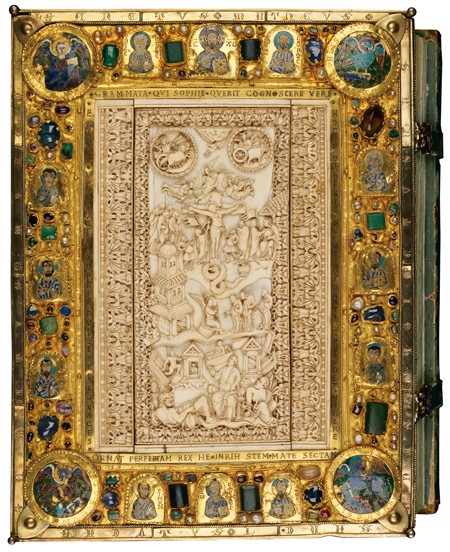That the Word of God was literally made flesh in bound transcriptions of the gospels such as the Pericope Book of Henry II is a commonplace among historians of medieval art. Scholars tend to emphasize the materiality of parchment as skin, but incarnation was a mathematical enterprise. Creation, in the Middle Ages, was understood to have been the act of a numerate god who made all things in “measure, number, and weight” (Wisdom 11:21). According to Plato’s Timaeus, a dialogue on the genesis of the cosmos that undergirded all medieval scientific speculation, matter comprised four elements, each related to a geometric solid: fire (pyramid), air (octahedron), water (icosahedron), and earth (cube).
The numeric order that underlay the universe was thought to govern the works of man as well. As much had been stated by Augustine of Hippo (354–430 CE) in his On Free Choice of the Will. “Craftsmen,” he wrote, “have numbers in their craft which they apply to their works.” For Augustine, mathematical and artistic form were enmeshed; order and beauty, intertwined—a point he drove home elsewhere: “Whatever delights you in a body and entices you through your bodily senses is full of number.” Here, the frisson of aesthetic pleasure experienced before an object arises from its denumeration—a word derived from the Latin dinumero, dinumerare, meaning to discern number, count, or reckon. Now obscure, the Latin term was common in the Middle Ages; its recuperation is, I hold, key to fully comprehending the medieval sensorium and visual culture around the turn of the millennium. Significantly, it was used in the Latin translation of the Timaeus. Plato claimed that the eyes were a divine gift and that the “supreme good” of vision was the ability to denumerate. This number-knowing capacity was deemed an inborn talent erased by original sin. Hence denumeration was taught, a skill diligently cultivated in monastic and cathedral schools through the four numeric disciplines of the quadrivium: arithmetic, geometry, music, and astronomy.
These twin notions, that number was the basis of matter and that the eyes were god-given instruments for number’s discovery, resulted in the profound interconnection of scientific investigation and artistic representation around the time the Pericope Book was made. The manuscript functioned as a vessel of divine presence in liturgical and legal settings. A physical stand-in for Christ, it was a nexus of veneration, devotion, and, I argue, denumeration. The poem incised on its spectacular, jewel-encrusted cover makes this clear. The anonymous author called the manuscript a “full square,” or cube. In so doing, he cast it as a kind of geometric demonstration, drawing attention to its quadrate form and three-dimensionality. Innate, these qualities have been largely overlooked in previous art-historical investigations, which have examined the front cover, book block, and back cover in isolation. Seeing the book as a “full square” requires understanding it as a complex whole and attending to its form. When God became human—homo in Latin; habitually etymologized as humus, meaning “earth”—he assumed aspects of the terrestrial domain, including its shape. Christ, in short, became a cube. Thus the quadrate codex was not a metaphor or sign for the sacred body; it was a sacred body, a holy corpus. Charged by Henry II (Holy Roman Emperor, 1014–1024) with making the Word of God flesh, the Ottonian craftsmen did so geometrically, according to the most up-to-date theories of corporeality and the mechanics of vision.
My study of the Pericope Book of Henry II is part of a larger project on the nature of numeracy and the quality of its effect on material culture in Latin-speaking Europe around 1000. Historians of all stripes have treated the central Middle Ages as a period that witnessed the eclipse of the “hard sciences” in Europe. Yet the era’s greatest intellects, chiefly Gerbert of Aurillac (c. 945–1003) and Abbo of Fleury (c. 944–1004), gained renown for their mathematical prowess and charismatic teaching. They educated a generation of elites and a host of clerics, monks, nuns, and priests. In the relatively closed economy of tenth- and eleventh-century Europe, these men and women were also the primary patrons, makers, and viewers of objects. All were numerate, and that numeracy had a demonstrable impact on their imaging as it did on their imaginations. I am developing this research into a book that challenges the standard narrative of the history of science sketched above and forces a reconsideration of the forms that rational knowledge adopted in the past, thus opening the way for a reconceptualization of the historical relationships between visual and scientific culture.
